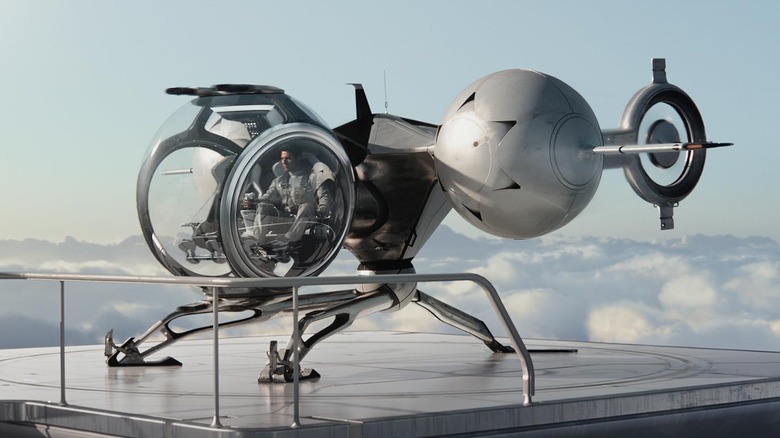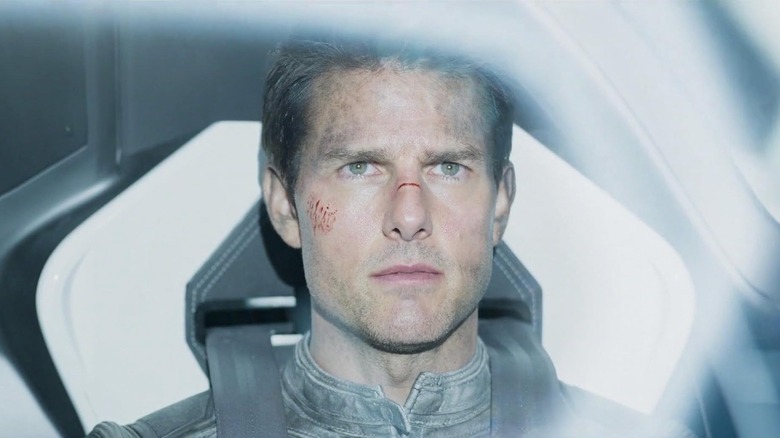Oblivion's Bubble Ship Could Have Been Much Different If It Weren't For Tom Cruise
"Oblivion" feels like the rare big-budget Tom Cruise vehicle that doesn't get talked about very much, despite being helmed by the A-lister's "Top Gun: Maverick" director Joseph Kosinski. The film casts Cruise as Jack Harper, a humble maintenance techie (and Yankees fan — sports enthusiasts, judge him as you will) who oversees operations on Earth in the wake of an alien attack that forced humanity to abandon the planet. All is not what it seems, though, as Jack keeps having visions of a mysterious woman from his past (Olga Kurylenko), only for her to abruptly crash-land on Earth out of the blue (or into the blue, as I guess it were). Basically, if you were to chuck "The Twilight Zone," "2001: A Space Odyssey," the original 1977 "Star Wars," and a handful of other '60s and '70s sci-fi titles into a blender, you might come up with something like "Oblivion."
"Oblivion" aims for a blend of big sci-fi ideas, emotional storytelling, and spectacle similar to Kosinski's feature directing debut on "TRON: Legacy," albeit with less success. (Yes, I'm a "TRON: Legacy" defender; let's move on.) Even so, it works better than its middling critical reception might suggest, in no small part thanks to the stellar production design inspired by the intriguing concepts and arresting visuals in Kosinski's original unpublished comic book of the same name. That's particularly the case when it comes to that nifty bubble ship Jack uses to traverse the post-apocalyptic Earth in the movie.
Cruise being who he is, you would half-expect him to insist on the bubble ship being made for real so he could actually fly it. But although the production didn't go quite that far, Cruise nevertheless played a hands-on role in determining the vehicle's look for the film, specifically that of the cockpit.
Cruise knows his way around the cockpit
Being a fully licensed pilot, you can take Cruise's word when it comes to all things aeronautics. Moreover, for practical purposes, you can trust him when it comes to how to safely operate a plane (unlike certain other actors who shall remain nameless). All of his aero-know-how proved immensely helpful to "Oblivion" concept designer Daniel Simon while crafting the bubble ship during pre-production, as the latter explained in a 2013 interview with Ace Magazine (via Syfy):
"There are actors who don't really have a relationship to the art department. They come to set and expect everything to be there. Tom saw the first drawings and was a part of it right from the beginning. Plus, he helped design the cockpit because of his expertise in flying. I can't fly an airplane or helicopter, he can. So he told us what would look best on-camera, what would make him comfortable acting. The biggest challenge was to make the seat comfortable. There's no secret about it, if you sit eight years in a chair, you suffer. It's not the healthiest position. So to make him, as an actor, very comfortable, this is specifically designed to his ergonomics."
Truth be told, the practical layout of the bubble ship's interior proves genuinely useful when it comes to the film's world-building and making it appear as though Cruise is honest-to-goodness using it to get around. It's those little touches that benefit Kosinski's film as a whole, giving it a little more substance to go beneath its shiny exterior. Throw in the fact that it's the rare original sci-fi movie to enjoy relative mainstream success over the last decade (and a fairly hard sci-fi movie at that), and "Oblivion" might just be due for a general re-evaluation.

